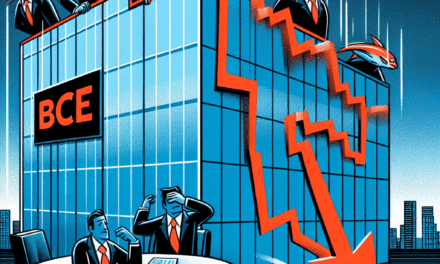“Tech Tumbles: Chip Woes Pull Indexes from Record Highs”
Introduction
Today, the stock market experienced a downturn as major indexes retreated from record highs, primarily driven by a significant decline in technology shares. The tech sector faced pressure due to a sharp sell-off in semiconductor stocks, which rippled across the broader market. Investors reacted to concerns over supply chain disruptions and potential regulatory challenges, leading to a cautious sentiment. This shift in market dynamics underscores the volatility and sensitivity of tech stocks to industry-specific news, impacting overall market performance.
Impact Of Chip Shortage On Tech Stocks
The stock market today witnessed a notable decline as major indexes fell from their record highs, primarily driven by a significant downturn in technology shares. This decline can be attributed to the ongoing global chip shortage, which has been exerting considerable pressure on the tech sector. The semiconductor industry, a critical component of the technology supply chain, is currently grappling with unprecedented demand and supply constraints. As a result, tech companies that rely heavily on these components are facing production delays and increased costs, leading to a ripple effect across the stock market.
The chip shortage, initially triggered by pandemic-induced disruptions, has been exacerbated by a surge in demand for electronic devices and automobiles. As remote work and digital transformation accelerated, the need for semiconductors skyrocketed, outpacing the industry’s capacity to produce them. Consequently, tech giants, which form a substantial portion of major stock indexes, are experiencing a slowdown in their growth trajectories. This slowdown is reflected in their stock prices, which have seen a downward trend, dragging the overall market lower.
Moreover, the impact of the chip shortage extends beyond immediate production challenges. It has also led to increased competition for available semiconductor supplies, driving up prices. Tech companies are now faced with the difficult decision of either absorbing these higher costs or passing them on to consumers, which could potentially dampen demand. This delicate balancing act is creating uncertainty among investors, who are wary of the potential long-term implications for profitability and market share.
In addition to these immediate concerns, the chip shortage is prompting a reevaluation of supply chain strategies within the tech industry. Companies are increasingly looking to diversify their supplier base and invest in domestic semiconductor manufacturing capabilities to mitigate future risks. While these strategic shifts may offer long-term benefits, they require significant capital investment and time to implement, further contributing to the current volatility in tech stocks.
Furthermore, the broader economic implications of the chip shortage cannot be overlooked. As technology companies play a pivotal role in driving innovation and economic growth, any sustained disruption in their operations could have far-reaching consequences. The tech sector’s influence on the stock market is substantial, and its struggles are likely to impact investor sentiment and market dynamics in the coming months.
Despite these challenges, there are reasons for cautious optimism. Governments and industry leaders are actively working to address the chip shortage through policy measures and increased investment in semiconductor manufacturing. These efforts, coupled with the tech industry’s inherent resilience and adaptability, may eventually alleviate some of the pressures currently weighing on the market.
In conclusion, the stock market’s recent decline underscores the significant impact of the chip shortage on tech stocks. As the industry navigates this complex landscape, investors and stakeholders must remain vigilant and adaptable. While the road to recovery may be fraught with challenges, the lessons learned from this crisis could ultimately lead to a more robust and resilient technology sector. As the situation continues to evolve, market participants will need to closely monitor developments and adjust their strategies accordingly to navigate the uncertainties ahead.
Analysis Of Recent Stock Market Index Declines
The recent decline in stock market indexes has captured the attention of investors and analysts alike, as the once-soaring figures have begun to falter. This downturn is primarily attributed to a significant rout in the semiconductor sector, which has exerted downward pressure on technology shares, a key driver of market performance in recent years. As we delve into the factors contributing to this decline, it is essential to understand the broader implications for the market and the potential ripple effects on the global economy.
To begin with, the semiconductor industry has been facing a series of challenges that have culminated in the recent sell-off. Supply chain disruptions, exacerbated by geopolitical tensions and the lingering effects of the COVID-19 pandemic, have led to shortages and production delays. These issues have not only affected the availability of chips but have also increased costs for manufacturers, thereby squeezing profit margins. Consequently, investors have grown increasingly wary of the sector’s short-term prospects, leading to a sell-off that has dragged down technology shares.
Moreover, the technology sector, which has been a stalwart of market growth, is now experiencing a period of recalibration. Valuations had reached unprecedented levels, driven by optimism about future growth prospects and the accelerated digital transformation across industries. However, as interest rates rise and monetary policies tighten, the cost of capital increases, prompting investors to reassess the sustainability of these high valuations. This shift in sentiment has contributed to the broader decline in tech shares, further impacting market indexes.
In addition to these sector-specific issues, macroeconomic factors have also played a role in the recent market downturn. Inflationary pressures have been mounting, fueled by robust consumer demand and supply chain bottlenecks. Central banks around the world are responding by signaling potential interest rate hikes, which could dampen economic growth and reduce corporate earnings. This environment of uncertainty has led to increased volatility in the markets, as investors grapple with the potential implications for their portfolios.
Furthermore, the global economic landscape is undergoing significant changes, with emerging markets facing their own set of challenges. Currency fluctuations, political instability, and varying rates of economic recovery have created a complex backdrop for investors. As a result, there is a growing sense of caution, as market participants weigh the risks and opportunities in different regions. This cautious approach has contributed to the recent declines in stock market indexes, as investors seek to mitigate potential losses.
Despite these challenges, it is important to recognize that market fluctuations are a natural part of the investment landscape. While the recent declines may cause concern, they also present opportunities for investors to reassess their strategies and identify potential areas for growth. Diversification, careful analysis, and a long-term perspective remain crucial in navigating these uncertain times.
In conclusion, the recent decline in stock market indexes can be attributed to a confluence of factors, including the semiconductor rout, recalibration of technology valuations, macroeconomic pressures, and global economic uncertainties. As investors navigate this complex environment, it is essential to remain informed and adaptable, recognizing that market dynamics are constantly evolving. By understanding the underlying causes of these declines, investors can better position themselves to capitalize on future opportunities and weather the inevitable ebbs and flows of the market.
Factors Contributing To The Tech Sector’s Downturn
The recent downturn in the tech sector has been a focal point for investors and analysts alike, as stock market indexes have retreated from record highs. This decline has been largely attributed to a significant rout in the semiconductor industry, which has had a cascading effect on technology shares. Understanding the factors contributing to this downturn requires a closer examination of both macroeconomic influences and industry-specific challenges.
To begin with, the semiconductor industry, a cornerstone of the tech sector, has faced a series of disruptions that have reverberated throughout the market. Supply chain constraints, exacerbated by geopolitical tensions and the lingering effects of the COVID-19 pandemic, have led to shortages in critical components. These shortages have not only hindered production capabilities but have also increased costs for tech companies reliant on these components. Consequently, investor sentiment has been negatively impacted, as concerns over profit margins and growth prospects have come to the forefront.
Moreover, the global economic landscape has introduced additional pressures on the tech sector. Rising inflation rates have prompted central banks to consider tightening monetary policies, which has led to increased volatility in the stock market. Higher interest rates typically result in higher discount rates for future earnings, making tech stocks, which are often valued based on their growth potential, less attractive. This shift in monetary policy expectations has therefore contributed to the sell-off in tech shares.
In addition to these macroeconomic factors, regulatory scrutiny has intensified, particularly for major tech companies. Governments around the world are increasingly focused on issues such as data privacy, antitrust concerns, and digital taxation. This regulatory environment has created an atmosphere of uncertainty, as companies may face potential fines, operational restrictions, or changes in business practices. Investors, wary of these potential disruptions, have responded by reevaluating their positions in tech stocks, further contributing to the sector’s downturn.
Furthermore, the tech sector’s recent performance must be contextualized within its previous trajectory. Over the past few years, technology stocks have experienced substantial growth, driven by rapid digital transformation and increased reliance on technology during the pandemic. This growth, while impressive, has led to elevated valuations, which some analysts argue are unsustainable in the current economic climate. As a result, the recent pullback may also be seen as a market correction, as investors reassess the long-term growth prospects of tech companies.
Despite these challenges, it is important to recognize that the tech sector remains a vital component of the global economy. Innovation continues to drive advancements in areas such as artificial intelligence, cloud computing, and renewable energy technologies. While short-term volatility may persist, the underlying demand for technological solutions is unlikely to diminish. Companies that can navigate supply chain disruptions, adapt to regulatory changes, and maintain competitive advantages are well-positioned to recover and thrive in the long run.
In conclusion, the recent downturn in the tech sector is the result of a confluence of factors, including semiconductor shortages, macroeconomic pressures, regulatory scrutiny, and market corrections. While these challenges have undoubtedly impacted investor sentiment and stock performance, the tech sector’s fundamental role in driving innovation and economic growth remains unchanged. As the market continues to evolve, stakeholders will need to carefully monitor these dynamics and adjust their strategies accordingly to capitalize on future opportunities.
How Chip Routs Influence Broader Market Trends

The stock market today witnessed a notable decline as major indexes fell from their record highs, primarily driven by a significant downturn in the semiconductor sector. This chip rout has exerted considerable pressure on technology shares, which are integral components of broader market indices. Understanding how such sector-specific downturns can influence broader market trends requires an examination of the interconnectedness of industries and the pivotal role technology plays in the modern economy.
Semiconductors are the backbone of the technology sector, powering everything from smartphones to data centers. Consequently, any disruption in this industry can have far-reaching implications. The recent decline in chip stocks can be attributed to a combination of supply chain disruptions, geopolitical tensions, and fluctuating demand forecasts. These factors have created an environment of uncertainty, prompting investors to reassess the valuations of tech companies heavily reliant on semiconductor components.
As technology companies constitute a significant portion of major stock indices, their performance can substantially sway overall market trends. When chip stocks experience a rout, it often triggers a ripple effect across the tech sector, leading to a broader market sell-off. This phenomenon is particularly pronounced in indices like the NASDAQ Composite, which is heavily weighted towards technology firms. As these companies face headwinds, their declining stock prices can drag down the entire index, influencing investor sentiment and market dynamics.
Moreover, the influence of chip routs extends beyond the technology sector. Many industries, such as automotive, healthcare, and consumer electronics, depend on semiconductors for their products and services. A downturn in the chip industry can lead to production delays and increased costs for these sectors, further impacting their stock performance. This interconnectedness underscores the systemic importance of semiconductors in the global economy and highlights why disruptions in this sector can have a cascading effect on broader market trends.
In addition to sector-specific impacts, chip routs can also affect macroeconomic indicators. For instance, prolonged supply chain issues in the semiconductor industry can contribute to inflationary pressures, as shortages drive up prices for electronic goods. Central banks may respond to rising inflation by adjusting monetary policies, which can influence investor behavior and market trends. Thus, the ramifications of a chip rout can extend to economic policy considerations, further illustrating its potential to shape broader market dynamics.
Investors, therefore, must remain vigilant in monitoring developments within the semiconductor industry, as these can serve as early indicators of potential market shifts. Diversification strategies may help mitigate risks associated with sector-specific downturns, but understanding the underlying causes and potential outcomes of a chip rout is crucial for informed decision-making. By staying attuned to industry trends and geopolitical developments, investors can better navigate the complexities of the stock market and anticipate how sector-specific challenges might influence broader market trends.
In conclusion, the recent decline in major stock indexes, driven by a chip rout, underscores the significant influence that the semiconductor industry wields over broader market trends. As technology shares falter, their impact reverberates across various sectors and economic indicators, highlighting the interconnected nature of modern markets. By recognizing the systemic importance of semiconductors and the potential for sector-specific downturns to affect broader market dynamics, investors can better position themselves to respond to these challenges and capitalize on emerging opportunities.
Strategies For Investors During Market Volatility
In the ever-evolving landscape of the stock market, investors are often faced with periods of volatility that can test even the most seasoned individuals. Recently, the stock market has experienced a downturn, with indexes falling from record highs, primarily driven by a significant decline in technology shares, particularly within the semiconductor sector. This chip rout has sent ripples across the market, prompting investors to reassess their strategies. During such turbulent times, it is crucial for investors to adopt strategies that not only protect their portfolios but also position them for future growth.
One effective strategy during market volatility is diversification. By spreading investments across various asset classes, sectors, and geographic regions, investors can mitigate the risks associated with a downturn in any single area. For instance, while technology stocks may be underperforming, other sectors such as healthcare or consumer staples might offer more stability. Diversification helps in balancing the portfolio, reducing the impact of adverse movements in specific stocks or sectors.
In addition to diversification, maintaining a long-term perspective is essential. Market volatility can often lead to emotional decision-making, where investors might be tempted to sell off assets in a panic. However, history has shown that markets tend to recover over time. By focusing on long-term goals and maintaining a disciplined approach, investors can avoid the pitfalls of short-term market fluctuations. This approach not only helps in weathering the storm but also in capitalizing on potential opportunities that arise during market corrections.
Moreover, investors should consider the importance of liquidity during volatile periods. Having a portion of the portfolio in liquid assets, such as cash or short-term bonds, provides flexibility and the ability to take advantage of market opportunities as they arise. This liquidity can be particularly beneficial when certain stocks or sectors become undervalued, allowing investors to buy at attractive prices.
Another strategy to consider is dollar-cost averaging, which involves investing a fixed amount of money at regular intervals, regardless of market conditions. This approach reduces the impact of market volatility by spreading out investments over time, thus averaging the purchase price. Dollar-cost averaging can be particularly effective during downturns, as it allows investors to acquire more shares when prices are low, potentially enhancing returns when the market rebounds.
Furthermore, staying informed and conducting thorough research is paramount during volatile times. Understanding the underlying factors driving market movements, such as economic indicators, geopolitical events, or industry-specific developments, can provide valuable insights for making informed investment decisions. By staying abreast of market trends and news, investors can better anticipate potential risks and opportunities.
Lastly, consulting with financial advisors or investment professionals can offer additional guidance and reassurance. These experts can provide personalized advice tailored to individual risk tolerance and financial goals, helping investors navigate the complexities of a volatile market.
In conclusion, while market volatility can be unsettling, it also presents opportunities for strategic investors. By employing strategies such as diversification, maintaining a long-term perspective, ensuring liquidity, utilizing dollar-cost averaging, staying informed, and seeking professional advice, investors can effectively manage their portfolios during turbulent times. These approaches not only help in safeguarding investments but also in positioning for future growth as the market stabilizes and recovers.
Historical Context Of Tech Stock Fluctuations
The stock market has long been a barometer of economic health and investor sentiment, with technology stocks playing a pivotal role in shaping market trends. Historically, the tech sector has been characterized by its volatility, driven by rapid innovation, regulatory changes, and shifting consumer preferences. This volatility is particularly evident in the fluctuations of major indexes, which often reflect the performance of tech giants. Recently, the stock market witnessed a decline from record highs, primarily due to a downturn in chip stocks, which subsequently dragged tech shares lower. To understand this phenomenon, it is essential to explore the historical context of tech stock fluctuations and their impact on the broader market.
The technology sector has experienced several boom-and-bust cycles over the past few decades. The dot-com bubble of the late 1990s serves as a prime example of how speculative investments in tech stocks can lead to dramatic market shifts. During this period, investors poured money into internet-based companies, driving stock prices to unsustainable levels. When the bubble burst in the early 2000s, it resulted in significant losses and a prolonged market downturn. This event underscored the inherent risks associated with tech investments and highlighted the need for careful analysis and prudent decision-making.
In the years following the dot-com crash, the tech sector gradually regained its footing, buoyed by advancements in digital technology and the proliferation of the internet. Companies like Apple, Microsoft, and Google emerged as dominant players, driving innovation and capturing substantial market share. The rise of social media platforms and e-commerce giants further fueled the sector’s growth, leading to a resurgence in tech stock valuations. However, this growth was not without its challenges. Regulatory scrutiny, cybersecurity threats, and geopolitical tensions have periodically disrupted the sector, causing fluctuations in stock prices.
The recent decline in tech shares, precipitated by a rout in chip stocks, can be attributed to several factors. Semiconductor companies are integral to the tech industry, providing the essential components for a wide range of electronic devices. Any disruption in chip production or supply chain issues can have a ripple effect across the sector. In this instance, concerns over supply shortages and geopolitical tensions have contributed to the downturn in chip stocks, subsequently impacting the broader tech market. Additionally, rising interest rates and inflationary pressures have prompted investors to reassess their risk exposure, leading to a shift away from high-growth tech stocks.
Despite these challenges, the tech sector remains a cornerstone of the global economy, with its influence extending beyond financial markets. The ongoing digital transformation across industries underscores the sector’s resilience and potential for future growth. As companies continue to innovate and adapt to changing market conditions, tech stocks are likely to experience periods of volatility. However, historical trends suggest that the sector’s long-term trajectory remains positive, driven by technological advancements and increasing consumer demand.
In conclusion, the recent decline in tech shares, driven by a chip stock rout, is a reminder of the sector’s inherent volatility. By examining the historical context of tech stock fluctuations, investors can gain valuable insights into the factors influencing market trends. While short-term challenges may persist, the tech sector’s enduring impact on the global economy underscores its potential for sustained growth and innovation. As such, investors should remain vigilant, balancing risk with opportunity as they navigate the ever-evolving landscape of technology stocks.
Future Outlook For The Technology Sector Amidst Supply Chain Issues
The technology sector, a cornerstone of modern economic growth, is currently navigating a complex landscape marked by supply chain disruptions and fluctuating market dynamics. Recent declines in major stock indexes, driven by a downturn in semiconductor stocks, have underscored the vulnerability of tech shares to these challenges. As the global economy continues to grapple with the aftermath of the COVID-19 pandemic, the technology sector faces a future that is both promising and fraught with uncertainty.
The semiconductor industry, which forms the backbone of the technology sector, has been particularly hard hit by supply chain issues. These disruptions have been exacerbated by a confluence of factors, including geopolitical tensions, natural disasters, and the ongoing effects of the pandemic. As a result, production delays and shortages have become commonplace, leading to increased costs and reduced output for tech companies reliant on these critical components. Consequently, investor confidence has been shaken, contributing to the recent decline in tech stock valuations.
Despite these challenges, the long-term outlook for the technology sector remains optimistic. The demand for technological innovation continues to grow unabated, driven by advancements in artificial intelligence, the Internet of Things, and 5G connectivity. These technologies are expected to revolutionize industries ranging from healthcare to transportation, creating new opportunities for growth and investment. Moreover, as companies adapt to the new normal of remote work and digital transformation, the reliance on technology is likely to increase, further bolstering the sector’s prospects.
In response to the current supply chain issues, many tech companies are taking proactive measures to mitigate risks and ensure continuity. Strategies such as diversifying supplier bases, investing in local manufacturing capabilities, and leveraging advanced technologies like blockchain for supply chain transparency are being implemented. These efforts not only aim to address immediate challenges but also to build more resilient and agile supply chains for the future.
Furthermore, governments around the world are recognizing the strategic importance of the semiconductor industry and are taking steps to support its growth. Initiatives such as the United States’ CHIPS Act and the European Union’s semiconductor strategy are designed to boost domestic production and reduce dependency on foreign suppliers. These policy measures are expected to provide a significant impetus to the technology sector, fostering innovation and enhancing competitiveness on a global scale.
However, it is important to acknowledge that the path to recovery will not be without hurdles. Inflationary pressures, fluctuating consumer demand, and potential regulatory changes pose additional risks that could impact the sector’s trajectory. Companies will need to remain vigilant and adaptable, continuously assessing market conditions and adjusting their strategies accordingly.
In conclusion, while the technology sector is currently facing headwinds due to supply chain disruptions, its future remains bright. The ongoing demand for technological advancements, coupled with strategic initiatives by both companies and governments, provides a solid foundation for growth. As the sector navigates these challenges, it will be crucial for stakeholders to collaborate and innovate, ensuring that the technology industry continues to thrive in an increasingly complex and interconnected world. Through resilience and adaptability, the technology sector is poised to overcome current obstacles and emerge stronger, driving economic progress and shaping the future of global industries.
Q&A
1. **What caused the stock market indexes to fall today?**
The indexes fell due to a rout in chip stocks, which dragged tech shares lower.
2. **Which sector was primarily responsible for the decline?**
The technology sector, particularly semiconductor or chip stocks, was primarily responsible for the decline.
3. **How did the major indexes perform today?**
Major indexes fell from their record highs.
4. **What specific stocks or companies were affected by the chip rout?**
Specific chip manufacturers and tech companies with significant exposure to the semiconductor industry were affected, though exact names would depend on the day’s market activity.
5. **Were there any other sectors impacted by today’s market movement?**
While the tech sector was the most impacted, other sectors might have experienced secondary effects due to overall market sentiment.
6. **Did any indexes manage to stay positive despite the tech decline?**
It would depend on the day’s specific market performance, but typically, if tech declines significantly, most major indexes are affected.
7. **What are analysts saying about the future outlook for tech stocks?**
Analysts might express caution due to current volatility in the semiconductor market but could remain optimistic about long-term growth prospects depending on broader economic conditions.
Conclusion
Today, the stock market experienced a downturn as major indexes fell from record highs, primarily driven by a significant decline in technology shares. This decline was largely attributed to a rout in semiconductor stocks, which exerted downward pressure on the broader tech sector. The sell-off in chip stocks reflects investor concerns over potential supply chain disruptions, regulatory challenges, or shifts in demand, which in turn affected market sentiment and led to a broader retreat in tech-related equities. As a result, the overall market saw a pullback from its recent peak levels.





